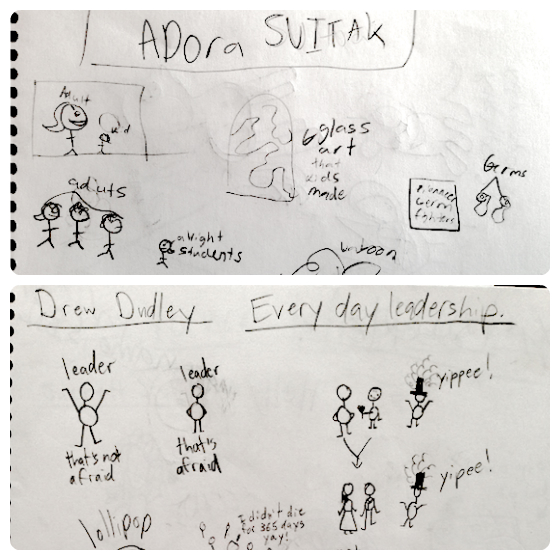
As art teachers, we are well aware of the power of visual communication. However, did you know that having students use visual note-taking strategies can boost comprehension and data retention by up to 30 percent? That’s amazing and a reason you should be considering using them in your classroom this year. Don’t worry, it’s not difficult; the strategies are simple to teach and simple to learn. In no time, your students will be harnessing the power of their doodles, sketches, and drawings to help them remember big ideas, small ideas, and everything in between. And, guess what? They’ll actually like taking notes.
Start With The Sketchnote Handbook
 A great place to start to learn these note-taking strategies is through Mike Rohde’s The Sketchnote Handbook, an easily accessible and inviting text. Sherrill Knezel, a Wisconsin art educator who was influenced by The Sketchnote Handbook, has been using these strategies extensively with her classes. I asked for some insight about how and why she utilizes this type of notetaking, and what her students gain from the process.
A great place to start to learn these note-taking strategies is through Mike Rohde’s The Sketchnote Handbook, an easily accessible and inviting text. Sherrill Knezel, a Wisconsin art educator who was influenced by The Sketchnote Handbook, has been using these strategies extensively with her classes. I asked for some insight about how and why she utilizes this type of notetaking, and what her students gain from the process.
“I stumbled onto The Sketchnote Handbookabout a year ago,” Sherrill said. “I love it because it is so clear, concise, and inviting. All I could think was, ‘this is how I’ve always taken notes!’ [Rohde] breaks it down into the basics you need to get started and reinforces that it is about ‘IDEAS, not ART.'”

After looking through the book, Sherrill knew she had to take the strategies into her classroom. After some research, she realized that her students needed to start sooner rather than later. “The most astounding fact I learned was that if you doodle or take visual notes, it can increase comprehension and data retention between 22-30%! How can we afford NOT to be teaching our students to do this? Right then and there I decided that all of my students would go on to middle school with these skills in their toolbox.”
Keep it Simple for Students
Visual literacy is not necessarily an easy idea to introduce to elementary students, but Sherrill figured out a winning activity that would work at any grade level. She told her students, “Listen for the pictures. When you listen to or read something, be aware of the images that pop up in your mind and draw them.”
She had her students watch a short 3-5 minute video and do just that. Sherrill says, “I suggested they draw 3-5 pictures of things they heard or things they thought were BIG ideas in the video. If they couldn’t think of a picture, they could just write a word.” Sherill’s goal was to have the students be able to take their sketchbook home and use their notes to tell a family member about the video. Below you can see the video as well as a student’s visual notes.

Sherrill says, “I talked with my students about how powerful visuals are. I told them that using visuals is another way to use their voice to tell a story and to help them remember information.”
This easy introduction allowed students to have success with visual note taking on the first try. From the first activity, it’s simply a process of developing visual note-taking skills–just like any other art skill we are trying to teach. Sherrill says that the more you practice the more you will develop a visual vocabulary, much like your verbal vocabulary. Visual note-taking will become faster and easier.
Start small–brief TED talks are a great place to begin. Sherrill recommended Drew Dudley’s Everyday Leadership, Adora Svitak’s What Adults Can Learn From Kids, and any Kid President videos. Here are a few examples of students’ notes about these clips.

Spread the Word
Another important point to make is that these strategies should not be limited to the art room. It can be tough to talk to other teachers about why kids should be drawing in their classes, but we live in such a visual world that it becomes almost imperative. When we can get teachers from outside the art room to realize that visual notetaking is a way to help their students learn, listen, engage, and understand, we are accomplishing something. If we can help those teachers get over that fear of drawing, and realize we’re talking about ideas–not art–they can see this is just another way to help our kids communicate more effectively.
Sherrill has a passion for visual notetaking and wants to see visual notetaking used and taught as a skill throughout the school–not just in the art room. Students are able to communicate with clarity, understand and connect with content, and learn in new ways.
If you’re just a little afraid to jump into the world of visual notetaking, Sherrill has some advice for you: “My motto with this whole journey has been Arthur Ashe’s wise words, ‘Start where you are. Use what you have. Do what you can.’ . . . until it catches on!”
A huge thank you to Sherrill for sharing her sound advice with us.
Have you ever tried visual notetaking strategies with your students?
What benefits do you see with this approach to taking notes?
Magazine articles and podcasts are opinions of professional education contributors and do not necessarily represent the position of the Art of Education University (AOEU) or its academic offerings. Contributors use terms in the way they are most often talked about in the scope of their educational experiences.




